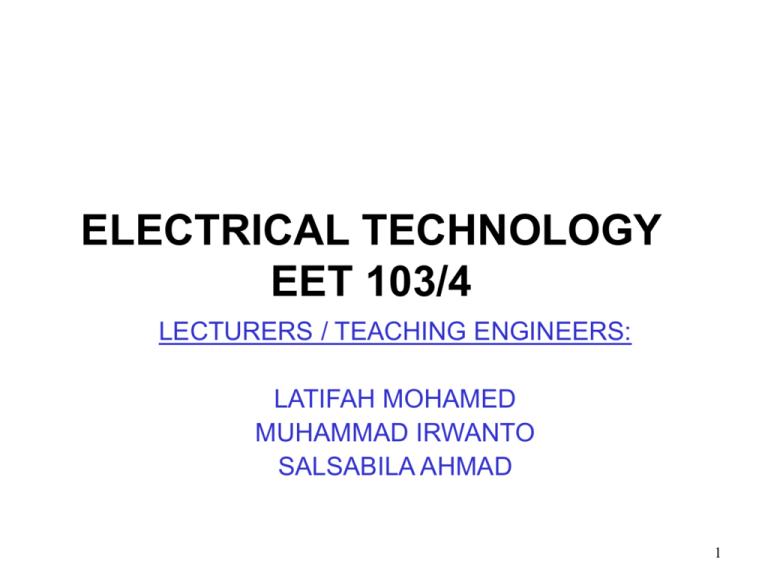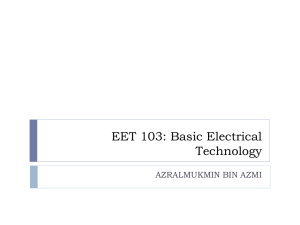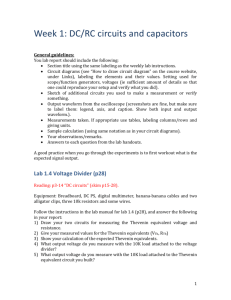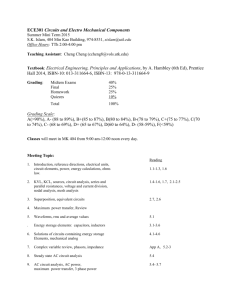
ELECTRICAL TECHNOLOGY
EET 103/4
LECTURERS / TEACHING ENGINEERS:
LATIFAH MOHAMED
MUHAMMAD IRWANTO
SALSABILA AHMAD
1
COURSE OUTCOME (CO)
• CO1: Ability to identify the principle elements
of DC and AC circuits such as current,
voltage, power, energy, nodes, branches, etc.
• CO2: Ability to compute the solution of DC
an AC circuits by using general methods for
the analysis of electric circuits
2
COURSE OUTCOME (CO)
• CO3: Ability to use the concept of magnetism
and electro magnetism to analyze the three
phase AC system.
• CO4: Ability to define and explain the basic
principles of electrical machines such as
transformers, DC motors, and AC motors.
3
TEACHING PLAN
• Lecture
MONDAY
(12.00 noon – 2.00 pm) – DKD 3
(4.00 pm – 6 pm) – DKP 2
FRIDAY
(8.00 am – 9.00 am) - DKD 2
(11.00 am – 12.00 noon ) – DKD 3
4
Lecture
Time
Room Group
12.00
–
DKD3
MON
2.00
FRI
Lecturer
9, 10,
Cik Latifah
14, 19
4.00 –
DKP2
6.00
8, 12,
13, 16,
18
8.00 –
DKD2
9.00
11.00
–
DKD3
12.00
9, 10,
Cik Latifah
14, 19
8, 12,
13, 16,
18
En.
Irwanto
En.
Irwanto
5
Lab. Experiments
TUE
WED
THU
FRI
Time
Group
8.00 – 10.00
11.00 – 1.00
3.00 – 5.00
5.00 – 7.00
8.00 – 10.00
12.00 – 2.00
3.00 – 5.00
4.00 – 6.00
8.00 – 10.00
18
12
14
19
13
9
10
8
16
Lecturer
Cik Latifah
Cik Latifah
En. Irwanto
En. Irwanto
Cik Latifah
Cik Latifah
En. Irwanto
En. Irwanto
En. Irwanto
6
ALL LAB. SESSIONS
WILL BE HELD IN
MEY 1
(Makmal Teknologi Elektrik)
Kampung Wai
7
SYLLIBUS
&
TEACHING PLAN
8
WEEK 1 & WEEK 2
Introduction and DC circuit
Define and explain the meaning of current,
voltage, resistance, power, conductor, and
insulator.
Explain and analyze series and parallel circuits
Explain, derive and analyze Ohm’s Law, Kirchhoff
Current Law, Kirchhoff Voltage Law, Source
Transformation, Thevenin theorem.
Lab 1: Introduction to basic laboratory
equipment (Week 2)
9
WEEK 3
Electromagnetic
Define and explain Faraday Law, Flemming Law,
magnetic field, magnetik material, Magnetisation
curve
Define and explain magnetic equivalent circuit,
electromagnetic induction, Sinusoidal excitation,
Lenz’s law.
Analyze and explain magnetic losses, eddy
current, hysterisis
Lab 2 : Ohm’s Law relationship
10
WEEK 4
& WEEK 5
AC Circuit
Define and explain sine wave, frequency, amplitude,
phase angle, complex number
Define, analyze and calculate impedance,
inductance, phase shifting
Explain and calculate active power, reactive power,
power factor
Define, explain, and analyze Ohm’s law, KCL, KVL,
Source Transformation, Thevenin theorem.
11
WEEK 4
& WEEK 5
TEST 1 – DC circuit (Week 4)
Lab 3 : Kirchhoff’s Law (Week 4)
Lab 4 : Thevenin’s and Norton’s
Theorems (Week 5)
12
WEEK 6
& WEEK 8
Three phase system
Explain and describe the single phase system,
three phase voltage generation and the phasor
diagram
Explain three phase connection: Wye and Delta
Calculate the phase and line voltages and
currents
Calculate the active and reactive power
13
WEEK 6
& WEEK 8
Test 2 : AC circuits (6th week)
Lab 5 : Single-phase transformer
(Week 6)
Lab 6 : Laboratory equipment test
(Week 8)
14
WEEK 9
& WEEK 10
Transformer
Define and analyze the principle of transformer,
its parameters and structure.
Describe and analyze Ideal transformer,
equivalent circuit, and phasor diagram
Calculate and justify efficiency, losses,
performance
Explain the principle of auto transformer and
three phase transformer.
15
WEEK 9
& WEEK 10
Lab 7 : Three-phase wiring system
(Week 9)
Lab 8: Three Phase AC Induction Motor
(Week 10)
16
WEEK 11
– WEEK 16
DC and AC Machines
Explain the operating principle, voltage and
torque equation.
Describe the motor classification, describe the
speed-torque characteristics, and calculate
losses and efficiency.
Explain the operating principle of three phase
induction motor, describe the speed-torque
characteristics, and calculate losses and
efficiency.
Describe other motors.
17
WEEK 11
– WEEK 16
Test 3 : Three-phase circuit (Week 11)
Lab 9: DC Series Motor (Week 11)
Lab 10: DC Shunt Motor (Week 12)
Tutorial 1
Tutorial 2
Tutorial 3
18
ASSESSMENT
• COURSEWORK: 50 %
– LAB WORKS : 20 %
– TESTS (3x) : 30%
• FINAL EXAM: 50 %
– 6 QUESTIONS, ANSWER 5Q ONLY
– EACH QUESTION 20 %
19
TEXT BOOK
Introductory Circuit Analysis,
Boylestad, Robert L.,
11th Edition, Prentice Hall, 2007.
20
REFERENCES
• Hughes, Electrical and Electronic
Technology, 9th Edition, Prentice Hall,
2005.
• Richard J. Fowler, Electricity Principles
and Applications, 7th Edition, Mc Graw Hill,
2008.
• Charles K. Alexander & Matthew
N.O.Sadiku, Fundamentals of Electric
Circuits, International Third Editions,
McGraw-Hill.
• Nilsson, J.W. & Riedel, S.A., Electric
Circuits, 7th Edition, Pearson Prentice
Hall, 2005.
21









